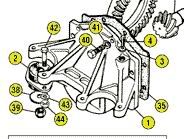Well, maybe not a TR250 differential...
Yesterday, I pulled the differential from my TR250 in preparation for new seals and bearings. Looking at it more carefully, I have discovered that the differential has a TR4A rear cover plate and mount. Here's one on Ebay that looks exactly like what I have on my diff: https://www.ebay.com/itm/TR4A-differentia...7a7&vxp=mtr
Furthermore, the number found on top of the diff is CTC 60762. Researching this number seems to indeed point to being a TR4a diff. Could this have been possible? Or just something replaced on the car over the years. The car's commission number, engine number, obvious original color, and heritage certificate all jive.
How can I tell what gear ratio is in the diff? There are other numbers on the casing but I'm not sure which, if any, denote gear ratio.
Should I just swap out the rear cover and mounting bracket? Replace the whole diff rather than bother with rebulding and switching the mount on this one? Or leave it the way it is?
The adventure continues...
Yesterday, I pulled the differential from my TR250 in preparation for new seals and bearings. Looking at it more carefully, I have discovered that the differential has a TR4A rear cover plate and mount. Here's one on Ebay that looks exactly like what I have on my diff: https://www.ebay.com/itm/TR4A-differentia...7a7&vxp=mtr
Furthermore, the number found on top of the diff is CTC 60762. Researching this number seems to indeed point to being a TR4a diff. Could this have been possible? Or just something replaced on the car over the years. The car's commission number, engine number, obvious original color, and heritage certificate all jive.
How can I tell what gear ratio is in the diff? There are other numbers on the casing but I'm not sure which, if any, denote gear ratio.
Should I just swap out the rear cover and mounting bracket? Replace the whole diff rather than bother with rebulding and switching the mount on this one? Or leave it the way it is?
The adventure continues...

 Hi Guest!
Hi Guest!

 smilie in place of the real @
smilie in place of the real @
 Pretty Please - add it to our Events forum(s) and add to the calendar! >>
Pretty Please - add it to our Events forum(s) and add to the calendar! >> 


